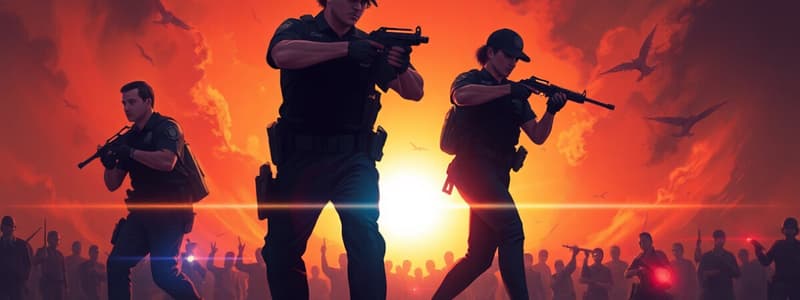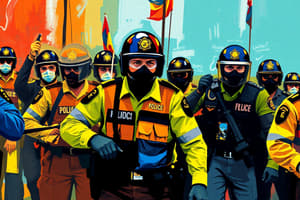Podcast
Questions and Answers
What is one example of active resistance?
What is one example of active resistance?
- The subject refuses to take his hands out of his pockets.
- The subject points a gun at the deputy.
- The subject pushes a member away when touched. (correct)
- The subject approaches the member with a fist.
Which situation constitutes aggressive resistance?
Which situation constitutes aggressive resistance?
- A subject physically anchors himself to an object.
- A subject attempts to run when grabbed by a member.
- A subject refuses to comply with a verbal order.
- A subject balls up his fist and approaches the member. (correct)
What defines deadly force resistance?
What defines deadly force resistance?
- The subject tries to escape after being touched.
- The subject argues verbally with the member.
- The subject complies with orders but maintains a defensive posture.
- The subject engages in movements that indicate intent to cause serious harm. (correct)
What should members prioritize when responding to a situation?
What should members prioritize when responding to a situation?
Which of the following is a characteristic of aggressive resistance?
Which of the following is a characteristic of aggressive resistance?
What type of resistance is illustrated when a subject refuses to drop a weapon when ordered?
What type of resistance is illustrated when a subject refuses to drop a weapon when ordered?
Which response style is effective in many situations before resorting to physical force?
Which response style is effective in many situations before resorting to physical force?
What describes the action of a subject physically anchoring himself to prevent removal?
What describes the action of a subject physically anchoring himself to prevent removal?
What must a member do after using non-deadly force against a subject?
What must a member do after using non-deadly force against a subject?
When is a member required to document the use of force incidents?
When is a member required to document the use of force incidents?
What is NOT a responsibility of the immediate supervisor following a use of force incident?
What is NOT a responsibility of the immediate supervisor following a use of force incident?
What defines the point of custody in relation to use of force incidents?
What defines the point of custody in relation to use of force incidents?
What should a member do if an incident involving use of force results in injuries?
What should a member do if an incident involving use of force results in injuries?
What is required of agencies regarding the handling of use of force documentation?
What is required of agencies regarding the handling of use of force documentation?
Which of the following is a key part of the Use of Force packet created by a supervisor?
Which of the following is a key part of the Use of Force packet created by a supervisor?
What action is not appropriate for a member after a use of force incident involving injuries?
What action is not appropriate for a member after a use of force incident involving injuries?
What constitutes intent in the context of perceived threats?
What constitutes intent in the context of perceived threats?
What is required when a member uses force in official capacity?
What is required when a member uses force in official capacity?
When is physical force considered to be used during compliance?
When is physical force considered to be used during compliance?
What is a condition for using reasonable force under an ex parte Baker Act order?
What is a condition for using reasonable force under an ex parte Baker Act order?
Multiple Use of Force Reports need to be generated when:
Multiple Use of Force Reports need to be generated when:
What scenario would necessitate completing a Use of Force Report?
What scenario would necessitate completing a Use of Force Report?
Which of the following actions does NOT constitute a use of physical force?
Which of the following actions does NOT constitute a use of physical force?
What should be documented for multiple uses of force against the same subject?
What should be documented for multiple uses of force against the same subject?
What is the primary purpose of less lethal impact munitions?
What is the primary purpose of less lethal impact munitions?
Who is authorized to use less lethal impact munitions?
Who is authorized to use less lethal impact munitions?
What must members do before using less lethal impact munitions?
What must members do before using less lethal impact munitions?
What constitutes deadly force according to the provided content?
What constitutes deadly force according to the provided content?
In what circumstances can chokeholds be used?
In what circumstances can chokeholds be used?
What is required after the deployment of less lethal impact munitions?
What is required after the deployment of less lethal impact munitions?
What does not constitute deadly force?
What does not constitute deadly force?
Which of these statements is true regarding the perception of threat and deadly force?
Which of these statements is true regarding the perception of threat and deadly force?
What is required for a law enforcement officer to be considered certified?
What is required for a law enforcement officer to be considered certified?
Which training related to firearm usage is mandatory for certified officers?
Which training related to firearm usage is mandatory for certified officers?
Which type of weapon is NOT permitted for use by agency members?
Which type of weapon is NOT permitted for use by agency members?
What responsibility does the Training Section have regarding firearms?
What responsibility does the Training Section have regarding firearms?
What must all certified officers carry while on or off duty?
What must all certified officers carry while on or off duty?
How does the agency ensure the safety of firearms in use?
How does the agency ensure the safety of firearms in use?
What is the main purpose of the use of force guidelines outlined by the Pasco Sheriff's Office?
What is the main purpose of the use of force guidelines outlined by the Pasco Sheriff's Office?
What is a requirement regarding less-lethal weapons training?
What is a requirement regarding less-lethal weapons training?
What document must all certified members receive?
What document must all certified members receive?
Under what circumstances is a member allowed to use force according to the guidelines?
Under what circumstances is a member allowed to use force according to the guidelines?
What principle defines appropriate force according to the guidelines?
What principle defines appropriate force according to the guidelines?
According to the use of force guidelines, when should an officer not retreat or desist from making a lawful arrest?
According to the use of force guidelines, when should an officer not retreat or desist from making a lawful arrest?
What does the term 'objective reasonableness' refer to in the context of the use of force?
What does the term 'objective reasonableness' refer to in the context of the use of force?
What should members be able to do after using force in a situation?
What should members be able to do after using force in a situation?
Which of the following restrictions is mentioned regarding members making an arrest?
Which of the following restrictions is mentioned regarding members making an arrest?
Which of the following is NOT a reason for using force as specified in the guidelines?
Which of the following is NOT a reason for using force as specified in the guidelines?
Flashcards
Purpose of Force
Purpose of Force
The use of force must be limited to situations involving resisting arrest, defense against physical assault, or force necessary to perform official duties.
Objective Reasonableness
Objective Reasonableness
The amount of force used must be objectively reasonable, considering the circumstances and threat level.
Force as a Last Resort
Force as a Last Resort
Members are required to use only the necessary amount of force to complete their official duties. Force should be used as a last resort.
When Force is Allowed
When Force is Allowed
Signup and view all the flashcards
No Duty to Retreat
No Duty to Retreat
Signup and view all the flashcards
Who does this order apply to?
Who does this order apply to?
Signup and view all the flashcards
What does this order do?
What does this order do?
Signup and view all the flashcards
Pasco Sheriff's Office Policy on Force
Pasco Sheriff's Office Policy on Force
Signup and view all the flashcards
Passive resistance
Passive resistance
Signup and view all the flashcards
Active Resistance
Active Resistance
Signup and view all the flashcards
Aggressive Resistance
Aggressive Resistance
Signup and view all the flashcards
Deadly Force Resistance
Deadly Force Resistance
Signup and view all the flashcards
Command Presence
Command Presence
Signup and view all the flashcards
Physical Force
Physical Force
Signup and view all the flashcards
Non-lethal Weapons
Non-lethal Weapons
Signup and view all the flashcards
Deadly Force
Deadly Force
Signup and view all the flashcards
Certification Requirements for Law Enforcement Officers
Certification Requirements for Law Enforcement Officers
Signup and view all the flashcards
Annual Firearm Proficiency Requirement
Annual Firearm Proficiency Requirement
Signup and view all the flashcards
Required Training for Law Enforcement Officers
Required Training for Law Enforcement Officers
Signup and view all the flashcards
Authorized Weapon Usage for Law Enforcement Officers
Authorized Weapon Usage for Law Enforcement Officers
Signup and view all the flashcards
Mandatory Firearm Carry for Law Enforcement Officers
Mandatory Firearm Carry for Law Enforcement Officers
Signup and view all the flashcards
Firearm and Ammunition Management
Firearm and Ammunition Management
Signup and view all the flashcards
Ongoing Training for Law Enforcement Officers
Ongoing Training for Law Enforcement Officers
Signup and view all the flashcards
Firearms and Less-Lethal Weapons Training Supervision
Firearms and Less-Lethal Weapons Training Supervision
Signup and view all the flashcards
Continuous Force Incident Reporting
Continuous Force Incident Reporting
Signup and view all the flashcards
Non-Deadly Force Reporting Responsibilities
Non-Deadly Force Reporting Responsibilities
Signup and view all the flashcards
Supervisor Responsibilities for Force Incidents
Supervisor Responsibilities for Force Incidents
Signup and view all the flashcards
Less Lethal Impact Munitions
Less Lethal Impact Munitions
Signup and view all the flashcards
Chokehold
Chokehold
Signup and view all the flashcards
Vascular Neck Restraint
Vascular Neck Restraint
Signup and view all the flashcards
Impact Munition
Impact Munition
Signup and view all the flashcards
Imminent Danger
Imminent Danger
Signup and view all the flashcards
Less Lethal Munition Deployment Procedures
Less Lethal Munition Deployment Procedures
Signup and view all the flashcards
Use of Force Report
Use of Force Report
Signup and view all the flashcards
Intent (Use of Force)
Intent (Use of Force)
Signup and view all the flashcards
Baker Act Orders
Baker Act Orders
Signup and view all the flashcards
Multiple Force Use
Multiple Force Use
Signup and view all the flashcards
Multiple Subjects
Multiple Subjects
Signup and view all the flashcards
Felony Traffic Stops
Felony Traffic Stops
Signup and view all the flashcards
Study Notes
Pasco Sheriff's Office Use of Force Order
- Title: Use of Force
- General Order: 1.5
- Effective Date: January 9, 2023
- Supersedes: July 22, 2022
- Accreditation Standards: CFA 4.01, 4.02, 4.03, 4.04, 4.05, 4.06, 4.07, 4.08, 4.09, 4.10, 15.15, 15.21
- Pages: 16
- Purpose: To establish guidelines and reporting requirements for the use of force by Pasco Sheriff's Office members
- Scope: Applies to all authorized members using force in their official capacity
- Discussion: Primary goal is protecting human life. Force is limited to situations involving resistance, defense against assaults, or completing official duties.
- Policy: Force should not be used indiscriminately or without cause. Objective reasonableness (Graham v. Connor) defines appropriate force as necessary to perform official duties.
Procedure (General)
- Members: Use only necessary force to conduct official duties. Do not use force unless necessary in self-defense, other's defense, overcoming resistance, or preventing escape.
- Certification: Members must complete required law enforcement or correctional state certification program, or be in field training, and demonstrate annual firearm proficiency.
- Training: Receive training concerning arrest, use of force, and first aid. Members must have received a copy of this General Order.
- Weapons: Only agency-approved weapons, firearms, and ammunition are permitted for on- or off-duty use. Any available tools can be used in emergency.
- Officer Duties: Certified officers must carry authorized firearms.
- Written Specifications: Training section maintains written specifications for all authorized firearms and ammunition.
Force Guidelines
- Framework: Guidelines outline constitutional considerations and case law to provide a framework for reasonable force decisions.
- Factors: Four factors determining appropriate force levels:
- Severity of the crime
- Whether the suspect poses an immediate threat
- Whether the suspect resists
- Whether the suspect attempts to flee
- Levels of Resistance:
- Passive resistance: Refusal to comply with lawful directions.
- Active resistance: Physically evasive movements.
- Aggressive resistance: Attacking movements possibly causing injury.
- Deadly force resistance: Attacking movements, with or without weapons, indicating intent to cause death or serious bodily harm.
Member Response Options
- Verbal/Nonverbal: Try to diffuse situations with verbal communication.
- Force Types: Physical control techniques are possible response options.
- Use of non-lethal weapons.
- Deadly force.
Reporting & Investigating Use of Force Incidents
- Purpose: To document all uses of force, including those involving multiple subjects or defendants within the same incident. If more than one incident occurs during the same incident, the documentation of the entire occurrence will be on a single report.
- Reporting: Reports (incident/use of force) must be submitted when force is used to gain compliance or a firearm is utilized.
- Supervisory Review: Use of force incidents require immediate notification to the supervisor, and details should be recorded in Offense and Use of Force reports.
Psychological Intervention
- Purpose: Provides a post-traumatic evaluation.
- Timeline: Immediate three-day administrative leave with a follow-up session within 60 days.
Studying That Suits You
Use AI to generate personalized quizzes and flashcards to suit your learning preferences.




